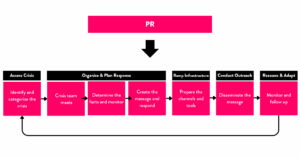Essential Strategies for Crisis Communications
Crisis communications is a subset of public relations that involves strategies and practices used to manage and respond to an event. Unfortunately, fewer than half (49%) of U.S. businesses say they actually have a formal crisis communications plan in place, according to a 2022 Capterra study.
There are a number of different types of crises that can unexpectedly affect an organization, from natural disasters and product recalls to executive misconduct, cyberattacks, and so much more. When a company is taken by surprise and mishandles the crisis, it could spiral out of control and potentially harm the corporate brand and bottom line. That’s why having a well-thought-out plan is essential. With this blog, we hope to prepare you—to be prepared.
We’ll cover:
- Components of a crisis communications playbook
- The importance of practicing and being prepared
- Post-crisis: evaluate and calibrate
Preparing a Crisis Communications Playbook
Having a pre-established plan can help an organization work through a crisis more effectively. The first step is building out the emergency response team. This team will be responsible for managing and executing the crisis communications plan. It typically will include corporate public relations, legal, senior management, and key department heads. Your marketing/PR agency is also an important component of this team. The plan should outline the chain of command, include contact information that can be used to reach people 24/7, and identify subject matter experts and spokespeople.
An important consideration about corporate spokespeople during a crisis: you can always go up, but you can’t go down—consider whether the CEO is the best first-level spokesperson during a crisis. Sometimes he/she is not. The head of a specific product line, human resources, legal, manufacturing, or customer service might be other options, depending on the nature of the crisis. You may also consider designating different spokespeople geographically that can speak in the local language.
A flowchart should be incorporated (Figure 1) that maps out the steps to take during the crisis and includes a checklist. (Remember, when a crisis situation arises, people are likely to be stressed and anxious, so planning the steps out ahead of time is helpful). The steps should include:
-
- Gather the facts
- Communicate internally first
- Consider the victim(s) and families, if applicable, before making a public statement
- Anticipate questions and answers and create an internal FAQ
- Develop and disseminate a holding statement
- Provide updates as facts come in or the situation develops
- Monitor media coverage & social media
- Evaluate the process after the crisis is over

Figure 1: Crisis Communications Flowchart.
All potential types of crises should be included in the plan along with special considerations for each. There are two types of crises, short-term incidents and longer-term situations:
-
Crisis Incident
The type of crisis “event” that comes to an end fairly quickly, such as a fire, earthquake, property damage, robbery, injury, death, employee violence, etc.
-
Crisis Situation
The type of crisis that may last over a longer period of time and will require additional planning and execution to deal with, such as an employee strike, data breach, lawsuit, acquisition, supply chain disruption, product recall, industry or geopolitical issue, economic downturn, etc.
Types of Crisis
There are a variety of different types of crises that can affect an organization, and each has its own level of severity. Here are the four general categories:
-
Employee Safety
Fire, property damage, robbery, injury, death, employee violence
-
External Factors
Protest/disturbance, data breach, lawsuit, acquisition, natural disasters, supply chain disruption, generative AI threats
-
Reputation
Any situation that could affect the reputation of the company – this can include financial or senior management incidents, social media/reputation management, product recalls, etc.
-
Current Affairs
Industry/customer issues, geopolitical issues, staffing/layoffs, economic downturn
Communication forms should also be included in the playbook so that everything is documented and available in one place when needed. This includes a questionnaire for gathering the facts of the crisis, media lists and contact information, media inquiry log, etc.
A holding statement should be prepared for the media during the crisis, and examples provided in the playbook. Holding statements are concise, simple statements about the situation that are delivered to all media and key stakeholders at the same time. The statement provides accurate and clear information, with no commentary, AND it should be compassionate in tone. The golden rule is empathy first, facts second.
The statement could be posted on social media channels and the company website. It is important to give the same message to all media and stakeholders to avoid confusion and risk of misreporting, rumors, etc. Updates to the holding statement can be provided as more facts are obtained and/or the crisis event evolves. Spokespeople should echo the written holding statement and not speculate about the situation. Media training is advised as part of the crisis communication practice sessions.
Practice for Preparedness
No plan is complete until it has been practiced. The full emergency management team should be involved in quarterly practice sessions. During these sessions, it is important for everyone on the team to understand their role in the event of a crisis, role-play for various types of crises, review and update the process.
The team should also consider what types of crisis events are missing from the plan; there may be some types of crises that are unique or specific to their technology, served markets, regional locations, etc. The quarterly session are also a good time to include media training, which your marketing/PR firm can provide.
Evaluate Lessons Learned from Crisis Communications
After the crisis event, consider how the situation was handled overall. Were there any gaps in the plan? Did everyone understand their role? Were they prepared? Did the situation play out as expected, or were there any surprises? Does the organization have a longer-term brand reputation issue that requires an additional plan of action? What else can the emergency response team do to be more prepared in the future? How likely is it that the crisis can happen again?
Crisis communications plans may not be perfect, but having a plan in place is far better than not having a plan at all. Being prepared to effectively handle a crisis helps manage public perception, maintain trust, and ensure that the organization can recover and continue operations after the crisis. Most importantly, having a strong brand reputation in place before the crisis will help to reduce any potential long-term negative effects.
For more information on building a crisis communication strategy, explore Kiterocket’s expertise in Renewable Energy, Microelectronics and Semiconductors, Future of Food or Emerging Technologies.


